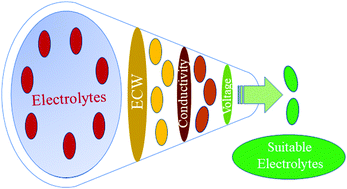Identifying suitable ionic liquid electrolytes for Al dual-ion batteries: role of electrochemical window, conductivity and voltage†
Abstract
Identifying suitable ionic liquid (IL) electrolytes with the desirable electrochemical properties remains a primary challenge for rechargeable Al dual-ion batteries (DIBs). Furthermore, it is also important to investigate how the size and structure of the cation determine the suitability of IL electrolytes in Al DIBs. In this work, with the help of first principles calculations, we have investigated a series of imidazolium-based room temperature ionic liquids (RTILs) by varying the alkyl substituents along with the pyrrolidinium electrolytes and molten salts such as urea/AlCl3 and acetamide/AlCl3. The suitability of the electrolytes is analyzed on the basis of three criteria: electrochemical window (ECW), ionic conductivity and voltage. The HOMO–LUMO positions of the electrolytes with respect to the Fermi positions of the respective electrodes can determine whether the electrolytes (EMIM-AlCl4, PMIM-AlCl4, BMIM-AlCl4 and urea-AlCl4) can perform as more suitable electrolytes, furnishing higher cationic reduction and anionic oxidation stability. Further, our calculated ionic conductivity data favor the usage of the EMIM-AlCl4 electrolyte as it shows the highest ionic conductivity (14.1 mS cm−1) amongst the considered electrolytes (3.4–12.4 mS cm−1). However, these considered electrolytes do not show drastically different effects on the average voltage, furnishing quite similar values in the range of 2.21–2.46 V, which are in accordance with their corresponding experimentally reported voltages. Overall, from these three criteria, we could certainly validate why EMIM-AlCl4 is the most experimentally used electrolyte in Al DIBs. Moreover, our study also predicts PMIM-AlCl4 to be a suitable ionic liquid electrolyte for Al DIBs, as it shows a higher ECW value (4.7 V), a moderate ionic conductivity (12.4 mS cm−1) and a suitable theoretical voltage (2.28 V) along with exhibiting a higher experimental coulombic efficiency compared to EMIM-AlCl4.



 Please wait while we load your content...
Please wait while we load your content...